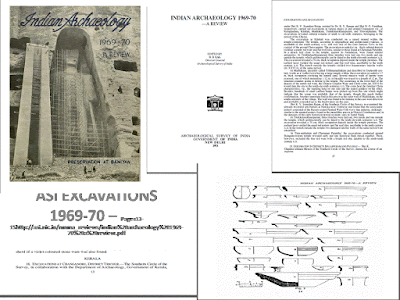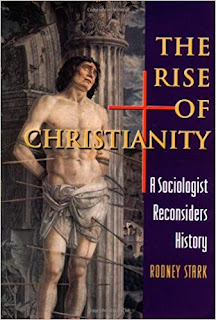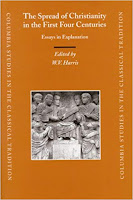அதாவது பைபிள் அப்போஸ்தலர் நடபடிகளில் ஆயிரக் கணக்ககில் மாறினர் என்பது எல்லாமே கட்டுக் கதை என்றும் மிகைப்படுத்தப் பட்ட பொய்கள் என்றார். ஸ்டார்க் ஏசுவின் மரணத்திற்கு 10 ஆண்டு பின்பு 1000 மக்கள் கிறிஸ்துவர் எனக் கொண்டு ஆண்டிற்கு 4% எனும் வளர்ச்சியைக் காட்டி 4ம் நூற்றாண்டூ ஆரம்பத்தில் 40 லட்சம் அதாவது அன்று ரோம் ஆட்சியில் கீழ் 7-8% என ஊகித்தர்.
ரோம் வாடிகனின் வரலாற்று ஆசிரியர் ப்ரூசு மலினா கத்தோலிக்க பைபிள் காலாண்டு இதழில் (1997) எழுதியது
Bruce Malina, who has argued that Stark’s estimated growth rate is too high:
220 bishops (so Henry Chadwick) attended the Council of Nicea called by Constantine in A.D. 325. These bishops functioned in a face-to-face society. Now in a face-to-face society the maximum number of persons with whom one can interact is ca. 4,000 (so the anthropologist, Jeremy Boissevain); hence, “scientifically” speaking (that is, mathematically), the number of Christians at the time of the Council of Nicea was ca. 880,000, the result of a growth rate of ca. 2.5 percent per year [hence Stark] postulates a growth rate that is exaggeratedly high. –
— Bruce Malina, Book Review of Rodney Stark’s The Rise of Christianity, in The Catholic Biblical Quarterly 59 (1997): pp. 593-595.
பொ.ஆ.325ல் நிசின் பாதிரிகள் மாநாட்டில் 220 பிஷப்புகள் கலந்து கொண்டனர், அன்று கால்நடை சமூகம், வாய் பேச்சு மூலம் பரவல் என்கையில் ஒரு பிஷப் 4000 கிறிஸ்துவருக்கு என்பது சர்ச் (மிகைபடுத்தப் பட்ட) பாரம்பரியம், எனவே வாடிகன் வரலாறுபடி 325ல் 8.85 லட்சம் மட்டுமே கிறிஸ்துவர் என்றார்.எனவே ஸ்டார்க் வளர்ச்சி வேகம் மிகப் படுத்திய கற்பனை என நிருபித்தார். வளர்ச்சி ஆண்டிற்கு 2.5% என்றார்.
பொ.கா.100 வாக்கில்வரலாற்று ஏசு மரணத்திற்கு 70 ஆண்டு பின்பு 3000 மக்கள் மட்டுமே கிறிஸ்துவர்கள்- 6 கோடியில். இருபதாயிரம் மக்களுக்கு ஒருவர் கூட இல்லை.
21:20 யூதருள் எத்தனையோ ஆயிரம்பேர்
மத்தேயு 10:23 உங்களுக்கு நான் உண்மையைச் சொல்லுகிறேன், மனிதகுமாரன் முன்பாக, நீங்கள் எல்லா யூதர்களின் நகரங்களுக்கும் செல்ல முடியாது.
ஏசு உலக அழிவு, அதன் முன் மனித குமாரன் வருகைக்கு முன் சீடர்களால் ஒரு சுற்று இஸ்ரேல் உள்ளே செல்ல இயலாது என்றார்.
அப்போஸ்தலர் 8:1 ஸ்தேவான் மரணத்திற்குப் பின் அப்போஸ்தலர்கள் மட்டுமே ஜெருசலேமில் தங்கினர்.செயின்ட் தாமஸ் எனும் கதைநபர்வருகை ஆதாரம் என்பது 4ம் நூற்றாண்டு ஆரம்பகாலத்தில் புனையப்பட்ட "தோமோ நடபடிகள்" எனும் நூல்.
"தோமோ நடபடிகள்" தோமோ மன்னர் மச்டாய் மனைவி குழந்தைகள் மீது சூனியம் வைத்து மதம் மாறியதால் மன்னர் மரணதண்டனை விதிக்க வீரர்கள் தண்டனை நிறைவேற்றினர் என்கிறது. அந்த மச்டாய் நாடு ஒரு பாலைவனம்
The Ninth Act: of the Wife of Charisius. 87 And when the apostle had said these things in the hearing of all the multitude, they trode and pressed upon one another: and the wife of Charisius the king’s kinsman Ieapt out of her chair and cast herself on the earth before the apostle, and caught his feet and besought and said: O disciple of the living God, Thou Art Come Into A Desert Country,For We Live In The Desert; In the desert country, few historians identify as Bahrain and found a Tomb also.
மேலும் 19ம் நூற்றாண்டில் மலயாளத்தில் புனையப்பட்ட ரம்பன் பாட்டு. கேரளாவில் கொடுங்கல்லூரில் வந்து தோமோ இரங்கியதாய் கதை
கொடுங்கல்லூர், சேரமான் பறம்பு, திருவஞ்சிகளம், கருப்பதனா, மதிலகம், கீழட்டலி & திருகுலசேகரபுரம் என கொடுங்கல்லூர் சுற்றி உள்ள அனைத்து பகுதிகளிலும் இந்தியத் தொல்பொருள் துறை சார்பாக நீண்ட ஆய்வுகள் நடந்தன. இந்த கேரள அகழ்வுகள் பற்றிய 1969- 70 இந்தியத் அகழ்வாய்வுகள் துறையின் ஆண்டு அறிக்கை பக்கங்கள்.

பேராசிரியர் கே.வீ.இராமன் "தொல்லியல் ஆய்வுகள்" என பதிப்பித்த நூலின் பக்கங்கள்

கொடுங்கல்லூருக்கு உள்ளும் புறமுமாக, பல முக்கிய இடங்களிலும் நடத்தப்பட்ட அகழ்வாய்வுகள் எல்லாவற்றிலும் கிடைத்த மிகப் பழைமையான படிவுகள் கி.பி.8 அல்லது 9-ஆம் நூற்றாண்டைச் சேர்ந்த்ததாகத்தான் உள்ளன. ஆக, ஓரே சீரான பண்பாட்டுக் கூறுகள் எல்லா இடங்களிலும் வெளிப்பட்டுள்ளன என்பது தெளிவாகிறது.
கொடுங்கல்லூர் பகுதியில், மனித சமுதாயத்தில் முதல் குடியிருப்புகள் 8,9-ஆம் நூற்றாண்டுகளில் தான் ஏற்பட்டிருக்க வேண்டும். குலசேகர மரபினர், கண்ணனூர்ப் பகுதியில் குடியேறி, அதைத் தங்களுடைய தலைநகராக கொண்ட பொழுது இந்தப் பகுதி முழுவதும் முக்கியத்துவம் பெற்றிருக்க வேண்டும். குலசேகர மரபினர்களைப் பற்றிய நல்ல காலக் கணிப்புகள் நமக்குக் கிடைத்திருக்கின்றன. ஆனால் அதற்கு முற்பட்ட காலத்தைச் சேர்ந்த எந்த விதமான ஆதாரமும் கிடைக்கவில்லை.. ..
கேரளாவை சேர்ந்த பாதிரியார் ரம்பன் பாட்டு பற்றி
www.stmaryssharjah.com, -and article titled ST. THOMAS THE APOSTLE- Written by Mr. Mathen Manathala says-
This tradition has many contradictions and factual errors. First of all there were no Brahmins in the Malabar Coast until the eight century. Secondly, the places where he is supposed to have founded churches were non existent as those parts of the western coast were still under the Arabian Sea. Thirdly, ordination of Kassesos and Rambans was not practiced in Christianity until the first quarter of the second century any where in the world. The only written evidence to this Malabar tradition is found in the Ramban Pattu supposed to be written in early 17th century, but the language used denotes a much later time, sometime in the 19th century.



